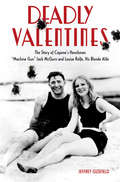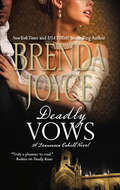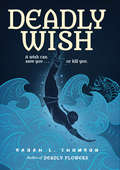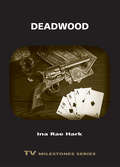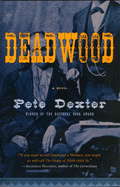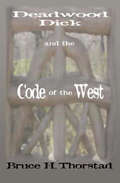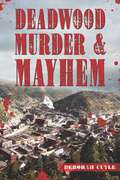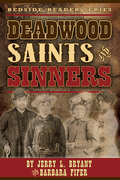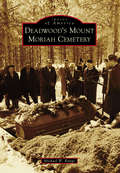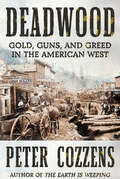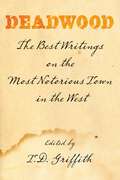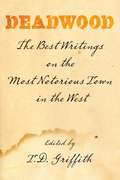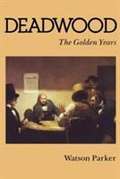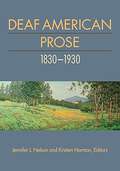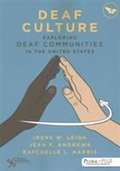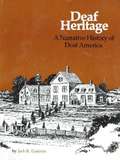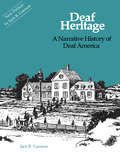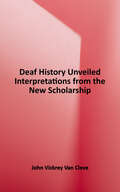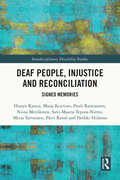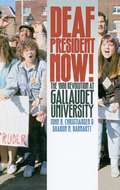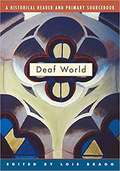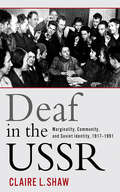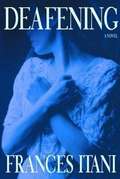- Table View
- List View
Deadly Valentines: The Story of Capone's Henchman "Machine Gun" Jack McGurn and Louise Rolfe, His Blonde Alibi
by Jeffrey Gusfield"An engrossing look inside Al Capone's murderous ranks." -Kirkus Almost before the gunsmoke from the St. Valentine's Day Massacre cleared, Chicago police had a suspect: "Machine Gun" Jack McGurn. They just couldn't find him. But two weeks later police found McGurn and his paramour, Louise May Rolfe, holed up at the Stevens Hotel. Both claimed they were in bed on the morning of the shootings, a titillating alibi that grabbed the public's attention and never let go. Chicago Valentines is one of the most outrageous stories of the Capone era, a twin biography of a couple who defined the extremes and excesses of the Prohibition era in America. McGurn was a prizefighter, professional-level golfer, and the ultimate urban predator and hit man who put the iron in Al Capone's muscle. Rolfe, a beautiful blond dancer and libertine, was the epitome of fashion, rebellion, and wild abandon in a decade that shocked and roared. Every newspaper in the country followed their ongoing story. They were the most spellbinding subject of the new jazz subculture, an unforgettable duo who grabbed headlines and defined the exciting gangland world of 1920s Chicago. The story of Jack McGurn and Louise Rolfe, two lovers caught in history's spotlight, is more fascinating than any fiction. They were the prototypes for eighty years of gangster literature and cinema, representing a time that never loses its allure. Jeffrey Gusfield, a native Chicagoan, researched the history of Jack McGurn, Louise Rolfe, and the Capone years for more than four decades.
Deadly Vows (The Francesca Cahill Novels #3)
by Brenda JoyceWhen a blackmailer threatens her future, a society sleuth must turn to the one man she can’t resist in this sexy Gilded Age mystery.New York City, 1902. On the morning of her wedding to Calder Hart, amateur sleuth Francesca Cahill is lured away to a private viewing of a portrait that could destroy her entire family: the nude that Hart has commissioned of her. Her desperate quest to recover the scandalous portrait leads her into a dangerous trap—one that keeps her from meeting Hart at the altar. And when Francesca finally arrives at the church, she finds it vacant.With her engagement over and a blackmailer intent on destroying her reputation, Francesca turns to Rick Bragg, the city’s powerful police commissioner. Together they scour the sordid streets of lower Manhattan, following a deliberately laid trail of clues in a race against the clock. And once it becomes clear that Bragg’s marriage is failing, Francesca must war with her feelings for him, battle Hart’s jealousy and escape a killer—all as she fights to win Hart back. But sometimes, passion just cannot be denied . . .
Deadly Wish: A Ninja's Journey (A\ninja's Journey Ser.)
by Sarah L. ThomsonThis sequel to Deadly Flowers is a fast-paced and compelling read with a multitude of astonishing plot twists. Kata is one of the best employees of a master thief until he sells her to Madame Chiyome, the woman who trained Kata as a ninja. It turns out that Madame Chiyome has been hired by Kata’s enemy, Saiko, to capture Kata and the magical pearl she possesses. But while escaping her enemies, Kata puts her trusted group of friends in danger. Should Kata stay loyal to her mission, as a true ninja would, or to her friends? Can Kata trust the fellow thief who says he is in love with her and wants to help her? The themes of trust versus independence underlie each of Kata’s decisions as she tries to get the pearl out of Japan to weaken the demon within it. As Kata faces one obstacle after another, including a wide range of supernatural creatures, she is tempted to make a wish to save herself, even though could it be the last wish, the one that frees the demon and lets him take her soul. Will her sense of duty and honor prevail against all odds?
Deadmen Walking: A Deadman's Cross Novel (Deadman's Cross #1)
by Sherrilyn Kenyon#1 New York Times bestselling author Sherrilyn Kenyon debuts a sweeping new epic saga sure to appeal to her millions of fans!Deadmen tell their tales . . . To catch evil, it takes evil. Enter Devyl Bane– an ancient dark warlord returned to the human realm as one of the most notorious pirates in the New World. A man of many secrets, Bane makes a pact with Thorn– an immortal charged with securing the worst creations the ancient gods ever released into our world. Those powers have been imprisoned for eons behind enchanted gates . . . gates that are beginning to buckle. At Thorn’s behest, Bane takes command of a crew of Deadmen and, together, they are humanity’s last hope to restore the gates and return the damned to their hell realms. But things are never so simple. And one of Bane’s biggest problems is the ship they sail upon. For the Sea Witch isn’t just a vessel, she’s also a woman born of an ancient people he wronged and who in turn wronged him during a centuries long war between their two races— a woman who is also sister to their primary target. Now Marcelina, the Sea Witch, must choose. Either she remains loyal to her evil sister and almost extinct race against Bane and his cause, and watches humanity fall, or she puts faith in an enemy who has already betrayed her. Her people over the totality of humanity— let’s hope Bane can sway her favor.Deadmen Walking is the first historical fantasy title in New York Times bestselling author Sherrilyn Kenyon’s Deadman’s Cross series. It is a tale of passion and loss, emotions that wound and heal…and ultimate redemptionAt the Publisher's request, this title is being sold without Digital Rights Management Software (DRM) applied.
Deadwood
by Ina Rae HarkConsiders the HBO series Deadwood in the context of the television Western genre and the intersection of capital and violence in American history.
Deadwood
by Pete DexterDEADWOOD, DAKOTA TERRITORIES, 1876: Legendary gunman Wild Bill Hickok and his friend Charlie Utter have come to the Black Hills town of Deadwood fresh from Cheyenne, fleeing an ungrateful populace. Bill, aging and sick but still able to best any man in a fair gunfight, just wants to be left alone to drink and play cards. But in this town of played-out miners, bounty hunters, upstairs girls, Chinese immigrants, and various other entrepreneurs and miscreants, he finds himself pursued by a vicious sheriff, a perverse whore man bent on revenge, and a besotted Calamity Jane. Fueled by liquor, sex, and violence, this is the real wild west, unlike anything portrayed in the dime novels that first told its story.
Deadwood Dick and the Code of the West
by Bruce H. ThorstadFourteen year-old Mortimer Ridley Chalmers III had cracked the Code of the West back in Philadelphia--in his treasured pulp novels. But in the Black Hills, Coffee Arbuckle is only aware of one code--protecting your own life with the best gun you can get. This Civil War Veteran is set spinning by the violent Gold Rush. He's in for about as much trouble as the teenage dreamer Mortimer, who's caught up in his books. But a partnership may be just the solution for these two desperadoes in a land where every man fights for his own interests.
Deadwood Murder & Mayhem (Murder & Mayhem)
by Deborah CuyleMalice, Menace and MendacityThe cast of characters coloring the Black Hills’ raucous past has inspired memorable Hollywood productions. Al Swearengen, “Wild Bill” Hickok and Calamity Jane have become celebrities, but many of the most malevolent moments did not produce household names. One of the more bizarre and unsolved murders was the Chinatown killing of a beautiful and rich woman named Di Lee. In 1894, Lakota Sioux warrior Chief Two Sticks was hanged for his band’s involvement in the brutal slayings of several cowboys and a few policemen at the Isaac Humphrey Ranch. Swearengen’s Gem Theater often played host to violence involving prostitutes, performers and patrons. Soiled dove Kitty Clyde was the victim of her spurned lover Charles Wilson, while “Banjo Dick” murdered his lover’s ex-husband in supposed self-defense. Author Deborah Cuyle combed local archives to tell the unvarnished accounts of Deadwood’s most daring and dastardly denizens.
Deadwood Saints and Sinners
by Barbara Fifer Jerry L. BryantWild Bill Hickok and Calamity Jane get all the press, but Deadwood was as rich in remarkable—and eccentric—personalities as it was in ore. Authors Bryant and Fifer have mined the archives for obscure (and true!) tales of murderous women, artful con men, woebegone children, an African American orator, a determined temperance activist, and a lovesick assayer. Discover Deadwood as it really was!
Deadwood's Mount Moriah Cemetery (Images of America)
by Mike RungeNestled on a mountainous plateau overlooking Deadwood’s downtown core district is one of the premier historic cemeteries in Black Hills: Mount Moriah Cemetery. Established in 1878, this cemetery contains some of North America’s most recognized Western legends, including James Butler “Wild Bill” Hickok, Martha “Calamity Jane” Canary, Seth Bullock, John “Potato Creek Johnny” Perrett, and Henry Weston “Preacher” Smith. They represent a small portion of the more than 3,600 people buried in Mount Moriah whose memories have been carved, chiseled, and etched into the monuments within this cemetery. Deadwood’s Mount Moriah Cemetery is a combination of historic and contemporary photographs chronicling the history of the cemetery and the stories of the individuals—both colorful and illustrious—who helped carve Deadwood into the annals of the American West.
Deadwood: Gold, Guns, and Greed in the American West
by Peter CozzensThe true story of the Black Hills gold rush settlement once described as &“the most diabolical town on earth&” and of its most colorful cast of characters, from Wild Bill Hickok to Calamity Jane to Al Swearingen and Sheriff Seth Bullock."In these pungent pages, you can smell the whiskey, the gunsmoke, the horse lather, the gold dust, and the mining chemicals . . . A fine non-fiction narrative that's as alluring as its subject.&” —Hampton SidesSifting through layers and layers of myth and legend—from nineteenth-century dime novels like Deadwood Dick, to HBO prestige dramas to the casino billboards outside of present-day Deadwood—Peter Cozzens unveils the true face of Deadwood, South Dakota, the storied mining town that sprang up in early 1876 and came raining down in ashes only three years later, destined to become food for the imagination and a nostalgic landmark that now brings in more than two and a half million visitors each year.That Western romance, we&’re reminded by Cozzens—the prizewinning author of The Earth Is Weeping—retains its allure only as long as we willfully ignore the town&’s foundational sins. Built on land brazenly stolen from the Lakotas, Deadwood was not merely a place where outlaws lurked, like Tombstone or Dodge City, but was itself an outlaw enterprise, not part of any U.S. territory or subject to U.S. laws or governance. This gave rise to the gunslinging, stagecoach robbing, whiskey guzzling, rampant prostitution, and gambling Deadwood is known for. But it also bred a self-reliance and a spirit of cooperation unique on the frontier, and made it an exceptionally welcoming place for Black Americans and Chinese immigrants at a time of deep-seated discrimination.The first book to tell this complex story in full, Deadwood reveals how one frontier town came to embody the best and worst of the West—a relic of humanity&’s eternal quest to create order from chaos, a greater good from individual greed, and security from violence.
Deadwood: The Best Writings On The Most Notorious Town In The West
by T. D. GriffithOf the many iconic towns of the old West, none has quite captured our imagination like Deadwood. From the legacy of Wild Bill Hickok and Calamity Jane to the current resurgence in mining and gambling, this city in the Black Hills of South Dakota continues to occupy a central place in the American mythos. Deadwood brings together the most captivating writings about the wildest town in the West, including excerpts from novels, period newspaper articles, biographies, and even song lyrics.
Deadwood: The Best Writings on the Most Notorious Town in the West
by T. D. GriffithOf the many iconic towns of the Old West, none has quite captured our imagination like Deadwood. From the legacy of Wild Bill Hickok and Calamity Jane to the current resurgence in mining and gambling, this city in the Black Hills of South Dakota continues to occupy a central place in the American mythos. Deadwood brings together the most captivating writings about the wildest town in the West, including excerpts from novels, period newspaper articles, biographies, and even song lyrics.
Deadwood: The Golden Years
by Watson ParkerDeadwood, South Dakota, has been a source of American legend for over one hundred years. European exploration, Indian wars, gold booms and busts, frontier shootouts, and the natural beauty of the surrounding Black Hills have all captured by Americans and foreigners. This book recreates the town that would not die, with wide-open frontier life side by side with a most mercantile respectability, a town that assimilated all that its geography, gold, natural disasters, and the extremes of human behavior could throw in its way. Deadwood was a microcosm of the American frontier and the gold rush town. This history of Deadwood emphasizes the period, 1875-1925, with careful scrutiny of before and after. Deadwood was real. This book a comprehensiveness rarely found. The next best thing to having lived there...
Deaf American Prose 1830-1930 (Volume 2 of the Gallaudet Deaf Literature Series)
by Jennifer L. Nelson Kristen C. HarmonThis new anthology showcases the work of Deaf writers during a critical formative period in their history. From 1830 to 1930, these writers conveyed their impressions in autobiographies, travel narratives, romances, non-fiction short stories, editorials, descriptive pieces, and other forms of prose. The quick, often evocative snapshots and observations featured here, many explicitly addressing deafness and sign language, reflect their urgency to record Deaf American life at this pivotal time. Using sensory details, dialogue, characterization, narrative movement, and creative prose, these writers emphasized the capabilities of Deaf people to counter events that threatened their way of life. <P><P> The volume opens with “The Orphan Mute,” a sentimental description of the misfortune of deaf people written by John Robertson Burnet in 1835. Less than 50 years later, James Denison, the only Deaf delegate at the 1880 Convention of Instructors of the Deaf in Milan, published his “impressions” that questioned the majority’s passage of a strict oralism agenda. In 1908, Thomas Flowers wrote “I was a little human plant,” a paean to education without irony despite the concurrent policy banning African Americans from attending Gallaudet College. These and a host of other Deaf writers—Laurent Clerc, Kate Farlow, Edmund Booth, Laura Redden Searing, Freda W. Bauman, Vera Gammon, Isaac H. Benedict, James Nack, John Carlin, Joseph Mount and many more—reveal the vitality and resilience of Deaf writers in an era of wrenching change.
Deaf Culture: Exploring Deaf Communities in the United States
by Irene W. Leigh Jean F. Andrews Raychelle L. HarrisHow does Deaf culture fit into education, psychology, cultural studies, technology and the arts? Deaf Culture: Exploring Deaf Communities in the United States addresses this through both theoretical and practical information. With the recognition of American Sign Language (ASL) as a bona fide language, the perception of Deaf people has evolved into the recognition of a vibrant Deaf culture centered around the use of signed languages and communities of Deaf people. This text also describes how rapid advances in technology, including the Internet as well as new visual and auditory technologies, have not only created opportunities for Deaf people to influence how technology can be used, but additionally has become a powerful force in influencing the behavior of Deaf individuals within diverse national and international societies. This has created opportunities for incorporating diversity and international perspectives into Deaf culture. Within each chapter are multiple vignettes, examples, pictures, and stories to enhance content interest for readers and facilitate instructor teaching. Theories are introduced and explained in a practical and reader-friendly manner to ensure understanding, and clear examples are provided to illustrate concepts. In addition, students of American Sign Language and Deaf Studies will find an introduction to possible opportunities for professional and informal involvement with ASL/Deaf culture children and adults. Deaf Culture fills a unique niche as an introductory text that is accessible and straightforward for those beginning their studies of the Deaf-World.
Deaf Heritage: A Narrative History of Deaf America
by Jack GannonThis in-depth history of Deaf America begins with an overview of the early years. Each chapter then covers a decade of history, beginning with 1880. The text is supplemented by marvelous pictures, illustrations, vignettes and biographical profiles. "Subchapters" chronicle the multi-facited dimensions of Deaf culture by focusing on Deaf athletes and more. A complete Deaf Culture course!
Deaf Heritage: A Narrative History of Deaf America
by Jack R. GannonNow, Jack R. Gannon's original groundbreaking volume on Deaf history and culture is available once again. In Deaf Heritage: A Narrative History of Deaf America, Gannon brought together for the first time the story of the Deaf experience in America from a Deaf perspective. Recognizing the need to document the multifaceted history of this unique minority with its distinctive visual culture, he painstakingly gathered as much material as he could on Deaf American life. The result is a 17-chapter montage of artifacts and information that forms an utterly fascinating record from the early nineteenth century to the time of its original publication in 1981.<P><P> Deaf Heritage tracks the development of the Deaf community both chronologically and by significant subjects. The initial chapter treats the critical topics of early attempts at deaf education, the impact of Deaf and Black deaf teachers, the establishment of schools for the deaf, and the founding of Gallaudet College. Individual chapters cover the 1880s through the 1970s, mixing milestones such as the birth of the National Association of the Deaf and the work of important figures, Deaf and hearing, with anecdotes about day-to-day deaf life. Other chapters single out important facets of Deaf culture: American Sign Language, Deaf Sports, Deaf artists, Deaf humor, and Deaf publications. The overall effect of this remarkable record, replete with archival photographs, tables, and lists of Deaf people's accomplishments, reveals the growth of a vibrant legacy singular in American history.<P> Advisory: Bookshare has learned that this book offers only partial accessibility. We have kept it in the collection because it is useful for some of our members. To explore further access options with us, please contact us through the Book Quality link on the right sidebar. Benetech is actively working on projects to improve accessibility issues such as these.
Deaf History Unveiled: Interpretations from the New Scholarship
by John Vickrey Van CleveDeaf History Unveiled features 16 essays, including work of Harlan Lane, Renate Fischer, Margret Winzer, William McCagg, and other noted historians in this field. Readers will discover the new themes driving Deaf history, including a telling comparison of the similar experiences of Deaf people and African Americans, both minorities with identifying characteristics that cannot be hidden to thwart bias. Other studies track societal paternalism toward deaf people in Italy, Hungary, and the United States. Adding to its intrigue, the new research in this milestone study provides evidence for previously uncredited self-determination of Deaf people in establishing education, employment, and social structures common throughout the Northern Hemisphere. Historians, teachers, and students will prize Deaf History Unveiled as a singular collection of insights that will change historical perspectives on the Deaf experience worldwide.
Deaf People, Injustice and Reconciliation: Signed Memories (Interdisciplinary Disability Studies)
by Hisayo Katsui Heikki Hiilamo Maija Koivisto Pauli Rautiainen Niina Meriläinen Suvi-Maaria Tepora-Niemi Merja Tarvainen Päivi RainoThis book focuses on injustices that have taken place to deaf people and the sign language community in Finland from 1900.For decades, memories and stories about past injustices have been passed down from one generation to another among deaf people and the sign language community. This research explains this history from the perspective of deaf people and their community and contributes to the truth and reconciliation process of the Finnish Government with the community, which is globally the first of its kind.Using participatory research methods, it is relevant for Disability Studies, Social Work, and Human Rights Studies, Political Science and History.
Deaf President Now!: The 1988 Revolution at Gallaudet University
by Sharon N. Barnartt John B. ChristiansenDeaf President Now! reveals the groundswell leading up to the history-making week in 1988 when the students at Gallaudet University seized the campus and closed it down until their demands were met. To research this probing study, the authors interviewed in-depth more than 50 of the principal players. This telling book reveals the critical role played by a little-known group called the "Ducks," a tight-knit band of six alumni determined to see a deaf president at Gallaudet. Deaf President Now! details how they urged the student leaders to ultimate success, including an analysis of the reasons for their achievement in light of the failure of many other student movements. This fascinating study also scrutinizes the lasting effects of this remarkable episode in "the civil rights movement of the deaf." Deaf President Now! tells the full story of the insurrection at Gallaudet University, an exciting study of how deaf people won social change for themselves and all disabled people everywhere through a peaceful revolution.
Deaf World: A Historical Reader and Primary Sourcebook
by Lois BraggTo many who hear, the deaf world is as foreign as a country never visited. Deaf World thus concerns itself less with the perspectives of the hearing and more with what Deaf people themselves think and do. Editor Lois Bragg asserts that English is for many signing people a second, infrequently used language and that Deaf culture is the socially transmitted pattern of behavior, values, beliefs, and expression of those who use American Sign Language. She has assembled an astonishing array of historical sources, political writings, and personal memoirs, from classic 19th-century manifestos to contemporary policy papers, on everything from eugenics to speech and lipreading, the right to work and marry, and the never-ending controversy over separation vs. social integration. At the heart of many of the selections lies the belief that Deaf Americans have long constituted an internal colony of sorts in the United States. While not attempting to speak for Deaf people en masse, this ambitious platform anthology places the Deaf on center stage, offering them an opportunity to represent the world--theirs as well as the hearing world--from a Deaf perspective. For Deaf readers, the book will be welcomed as a gift, both a companion to be savored and, as often, an opponent to be engaged and debated. And for the hearing, it serves as an unprecedented guide to a world and a culture so often overlooked. Comprising a judicious mix of published pieces and original essays solicited specifically for this volume, Deaf World marks a major contribution.
Deaf in Japan: Signing and the Politics of Identity
by Karen NakamuraUntil the mid-1970s, deaf people in Japan had few legal rights and little social recognition. Legally, they were classified as minors or mentally deficient, unable to obtain driver's licenses or sign contracts and wills.
Deaf in the USSR: Marginality, Community, and Soviet Identity, 1917-1991
by Claire L. ShawIn Deaf in the USSR, Claire L. Shaw asks what it meant to be deaf in a culture that was founded on a radically utopian, socialist view of human perfectibility. Shaw reveals how fundamental contradictions inherent in the Soviet revolutionary project were negotiated—both individually and collectively— by a vibrant and independent community of deaf people who engaged in complex ways with Soviet ideology.Deaf in the USSR engages with a wide range of sources from both deaf and hearing perspectives—archival sources, films and literature, personal memoirs, and journalism—to build a multilayered history of deafness. This book will appeal to scholars of Soviet history and disability studies as well as those in the international deaf community who are interested in their collective heritage. Deaf in the USSR will also enjoy a broad readership among those who are interested in deafness and disability as a key to more inclusive understandings of being human and of language, society, politics, and power.
Deafening
by Frances ItaniThis novel interweaves the lives of its two main characters - Grania, deaf since age five; and her husband Jim, who serves as a medic on the battlefields of World War I. The story begins with Grania's childhood in a small Canadian town, and her years at a residential school for the deaf. Her relationships within her family are portrayed with insight and depth. Jim leaves for Europe two weeks after his marriage to Grania, and much of the book involves his horrifying experience of the war. The author based Grania's character on her own grandmother, who was deaf, and has done extensive research on both deaf history and the social history of the World War I era. This is an absorbing novel and gives a refreshingly rounded depiction of a woman with a disability.
